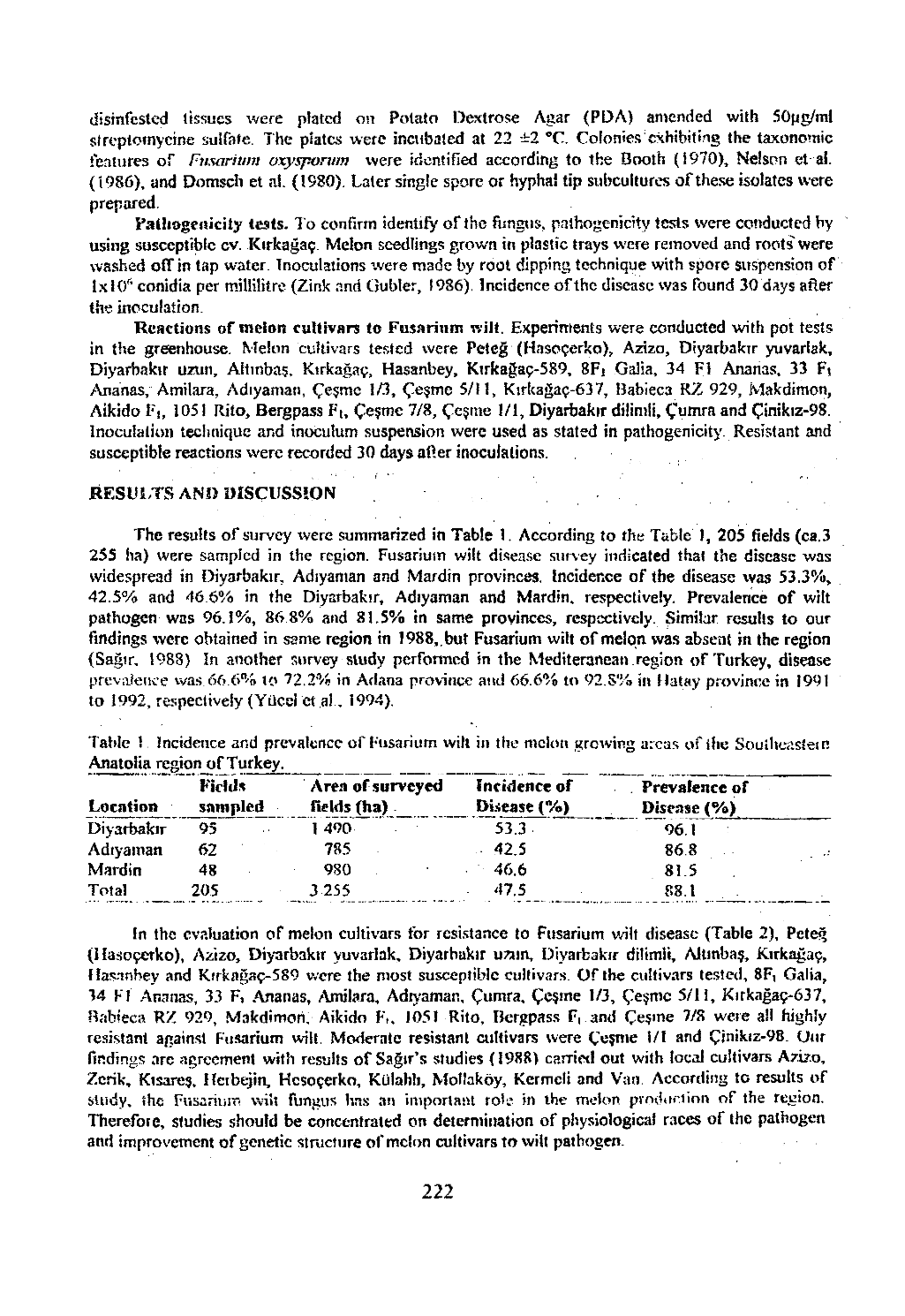

disinfested tissues were plated on Potato Dextrose Agar (PDA) amended with 50pg/ml
streptomycine sulfate. The plates were incubated at 22 ±2 °C. Colonies exhibiting the taxonomic
features of
Fusarium oxysporum
were identified according to the Booth (1970)* Nelson et ai.
(i9S6), and Domsch et a!. (1980). Later single spore or hyphai tip subcultures of these isolates were
prepared.
Pathogenicity tests. To confirm identify of the fungus, pathogenicity tests were conducted by
using susceptible cv. Kirkagaip. Melon seedlings grown in plastic trays were removed and roots were
washed off in tap water. Inoculations were made by root dipping technique with spore suspension of
lxI0rt conidia per millilitre (Zink and Gubler, 1986). Incidence of the disease was found 30'days after
the inoculation.
Reactions of melon cultivars to Fusarium wilt. Experiments were conducted with pot tests
in the greenhouse. Melon cultivars tested were Peteg (Haso^erko)* Azizo, Diyarbakir yuvariak,
Diyarbakir uzun, Aitmbas, Ktrkagav, Hasanbey, Kirkaga9-589, 8Fi Galia, 34 FI Ananas, 33 F|
Ananas, Amilara, Adiyaman, £е$те 1/3, <^e$mc 5/11, Kirkaga9-637, Babieca
RZ 929,
Makdimon,
Aikido Fb 1051 llito, Bergpass Ft>Ce?me 7/8, Ce§rne 1/1, Diyarbakir dilimii, (^umra and Cinikiz-98.
Inoculation technique and inoculum suspension were used as stated in pathogenicity. Resistant and
susceptible reactions were recorded 30 days after inoculations.
RESULTS AND DISCUSSION
The results of survey tvere summarized in Table 1. According to the Table 1, 205 fields (ca.3
255 ha) were sampled in the region. Fusarium wilt disease survey indicated that the disease was
widespread in Diyarbakir, Adiyaman and Mardin provinces. Incidence of the disease was 53.3%,
42.5% and 46 6% in the Diyarbakir, Adiyaman and Mardin, respectively. Prevalence of wilt
pathogen was 96.1%, 86 8% and 81.5% in same provinces, respectively. Similar results to our
findings were obtained in same region in 1988, but Fusarium wilt of melon was absent in the region
(Sagtr. 1988) In another survey study performed in the Mediteranean region of Turkey, disease
prevalence was.66.6% to 72.2% in Adana province and 66 6% to 92.5% in flatay province in 1991
to 1992, respectively (Yticci et a l. 1994).
Table I Incidence and prevalence оГ Fusarium wilt in the melon growing areas of the Southeastern
Anatolia region of Tu rk ey .______________ _________ ____ _________
Fields
Area of surveyed Incidence of
Prevalence of
Location
sampled
fieW sJha)__ Disease (% )
Disease <%)
Diyarbakir
95
i 490
” 53.3
96.1
Adiyaman 62
785
42,5
86.8
Mardin
48
980
46.6
81.5
Total
205
3 255
47.5
88.1
In the evaluation of melon cultivars tor resistance to Fusarium wilt disease (Table 2), Peteg
(I lasoyerko), Azizo, Diyarbakir yuvariak, Diyarbakir uzun, Diyarbakir dilimii, Aitinba?, Kirkaga?,
ffasnnbey and Kirkagao-589 were the most susceptible cultivars. Of the cultivars tested, 8F, Galia,
14 FI Ananas, 33 F, Ananas, Amilara, Adiyaman, (pumra, £e$me 1/3, £e$me 5/1!, Kirkaga9~637,
Rabteca RZ 929, Makdimon, Aikido F», 1051 Rito, Bergpass F, and Ce$me 7/8 were all highly
resistant against Fusarium wilt. Moderate resistant cultivars were Cv$me 1/1 and £jnikiz-98. Our
findings are agreement with results of Sagir’s studies (1988) carrier! out with local cultivars Azizo,
Zcrik, Kisare$, Herbejin, Hcso
9
erko, Kulahli, Mollakoy, Kermcli and Van According to results of
study, the Fusarium wilt fungus has an important role in the melon production of the region.
Therefore, studies should be concentrated on determination of physiological races of the pathogen
and improvement of genetic structure of melon cultivars to wilt pathogen.
222
Научная электронная библиотека ЦНСХБ









